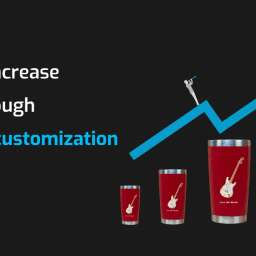
Always focus on customers; that is what every business marketing strategy is all about. Grab your customers’ attention and you are bound to increase sales. But the question persists: do you really know your customers?
Of course you don’t need to know your customers on a personal level. But understanding their needs and wants can help you strategize a better marketing campaign. That is where a buyer’s persona comes in: it helps you understand your customers better with proven results. HubSpot showcased this where they saw websites with personas were almost 5x more effective.
But how can you make the buyer’s persona even better? The answer is by crafting buyer’s persona with product personalization. It connects your product with your customer through your marketing. So let’s understand everything there is to a buyer’s persona, what you need to craft the perfect one, and how you can best use it for a successful marketing campaign!
Understanding What Is A Buyer’s Persona
Every business relies on understanding their customer base. It pairs the right marketing strategies to the most compatible customers to craft a personalized buyer’s persona. But what exactly is a buyer’s persona?
Imagine you’re trying to sell a product without knowing who will buy it. You try to please a wide audience but it ends up hurting your business because you are not connecting with any of your actual customers. Your business ends up with lost sales and your actual customers are looking elsewhere because they didn’t find your marketing appealing. That is where a buyer’s persona comes in. It’s about seeing your customers not just as data points, but as real people with real lives and preferences.
Think of a buyer’s persona as a representation of a real person. This person is one of your many customers, but they represent everyone who is similar to this persona. The persona itself is fictional; made up to reflect the type of ideal type of customer for your business. With this persona, your business can visualize the target audience and personalize the marketing strategies to their specific needs, behaviors, and concerns.
3 Key Stages of the Buyer’s Journey: Tailoring Buyer Personas for Maximum Impact
A buyer’s persona is great, but every customer is on a different stage of their journey when buying your product. Some are at the beginning when they are thinking of a product that can help them. Some are in the middle, while others are at the end when they are deciding which product to buy.
The buyer’s journey is a process that every potential customer goes through before making a purchase. When you combine a buyer’s journey with a persona that matches their challenges and needs, you personalize the marketing to connect with your customers. So understanding where your customers are on their buying journey is necessary when you want to make an attractive buyer’s persona.
So, here are the stages to help you better understand the buyer journey:
- Awareness Stage: The buyer realizes they have a problem or need. At this point, they are looking for information to understand their issue better.
- Consideration Stage: The buyer defines their problem and researches options to solve it. They are evaluating different approaches or methods available.
- Decision Stage: The buyer chooses a solution. They compare different products or service providers, read reviews, and decide which one best matches what they need.
It is all about understanding consumer perception by knowing where they are on their journey. That way, you can personalize your marketing and make your product attractive enough to be the first choice.
Making A Buyer’s Persona For Your Business In 5 Detailed Steps
Here is how you make a buyer persona with product personalization for your business:
Step#1 Conduct Thorough Customer Research
Before you start creating your buyer’s persona, gather as much information as possible about your customers. This includes both quantitative data (like age, gender, income) and qualitative insights (like goals, challenges, and motivations).
- Surveys and Interviews: Reach out to your existing customers through surveys or interviews. Ask open-ended questions to gain deep insights into their preferences and pain points.
- Social Media and Analytics: Use social media platforms and website analytics to track customer behavior and gather additional data. Look for patterns and trends in how your customers are interacting with your marketing. This will help you understand your audience better.
Step#2 Identify Common Traits and Patterns
Once you have gathered your data, start looking for common traits and patterns among your customers. This step is crucial for segmenting your audience into distinct groups that share similar characteristics.
- Demographics: Group your customers by age, gender, location, and occupation. These basic traits help you create a broad picture of your audience.
- Behavioral Patterns: Pay attention to how customers interact with your brand. Identify common behaviors such as purchasing habits, preferred communication channels, and frequently visited pages on your website.
Step#3 Create Detailed Persona Profiles
Now that you have segmented your audience, it’s time to create detailed profiles for each group. Give each persona a name and backstory to make them more relatable and real.
- Name and Background: Choose a name for your persona and write a brief background story. For example, “Jane, a 35-year-old senior marketing manager living in New York looking for the best hotdogs in upper Manhattan near where she works.”
- Goals and Challenges: Define the primary goals and challenges for each persona. What are they trying to achieve, and what obstacles do they face? This helps you understand their motivations and pain points.
Step#4 Understand Customer Buying Behavior
Dive deeper into the buying behavior of your personas. This step is about understanding how they make purchasing decisions and what factors influence them.
- Decision-Making Process: Identify the steps your persona takes before making a purchase. Do they rely on reviews, seek recommendations, or compare multiple options? Or, are there multiple decision-makers in a business that you need to market towards?
- Influence Factors: Determine what influences their decisions the most. Is it price, quality, brand reputation, or customer service? Knowing this helps you tailor your messaging effectively.
Attaching these behaviors to the profiles you have created in the earlier step will help create a well-rounded buyer persona that will align with your actual customer base.
Step#5 Use Personas to Personalize Marketing Strategies
With your detailed buyer personas ready, you can now use them to personalize your marketing strategies. This ensures your messages resonate with your target audience on a deeper level.
- Tailored Content: Create content that addresses the specific needs, interests, and challenges of each persona. These could be blog posts, social media updates, or email campaigns.
- Personalized Offers: Develop special offers and promotions that appeal to the unique preferences of each persona. Personalized discounts or product recommendations can significantly boost engagement and sales.
- Focus On Unique Selling Points: what makes your business stand out from the rest? In your marketing, you should highlight your unique selling points or USPs to attract customers away from your competitors.
Combining Your Buyer’s Persona With A Product Personalizer On Shopify
Having a buyer’s persona and coming up with effective marketing is one thing, but executing a unique experience for your customers is completely different. Product personalization is all about making the product feel as personal as possible for the customers. When they feel a certain level of connection, you have the potential to connect that customer with your product. But again, executing it is rather difficult because of there being so many distinct types of customers. But, what if I were to tell you there might be a way for your e-commerce business on Shopify to do exactly that?
Shopify allows your store to have third party integration from their own app store. Here, you can add in apps that personalize your store’s shopping experience to match your customers. Take, for example, this product personalizer that leaves the T-shirt design completely in the hands of your customer:

There is a lot going on so let’s break this down.
On the top left, you can see all the different personalization options available. Customers can add text, existing graphics, or upload their very own picture to add to the product. The upload part is huge because your business gives the customers the ultimate personalization experience. They can upload a picture of their choosing on the picture and you can print it for them.
On the right, you will notice the product view for the front and back of the T-shirt. Now imagine, a normal store has only a front design, but your customers want only designs on the back. You are giving the customers the option to choose how they want to personalize their T-shirt! Whether the front or the back, the app lets you set up configurable product sides and print location. If you want, then you could have also set up the short sleeves to be customizable as well.
Now what if they want to look at how they can customize a different product you offer? On the top-right, you have the option to showcase all the customizable products in your store! Your customers can browse all of them in the design lab and choose the one they want to design and personalize.
Since this is an e-commerce store on Shopify, customers have limited contact with the store. But, with the “Add Note” button on the bottom right, you allow your customers to give you their specification or what they want to see in the final design. It opens a path of communication so you can offer a completely personalized experience for them only! They can also save their design to double check if it matches with the final product too.
This type of personalization gives your business the vast advantage to cater to all different types of personas. You give them all the options to design the product how they want, deepening the personalization experience to a level other businesses just cannot provide. In return, you get different customer segments, all satisfied with personal shopping experience. With this product personalizer, all of this is possible for your business!
6 Benefits Of Crafting Buyer’s Persona With Product Personalization (With Examples)
So buyer’s persona does help your business improve. But where will you see the most benefits for your business if you develop detailed personas? Here are some benefits with examples that will make it clearer:
Benefit#1 Better Understanding Of Customer Sentiment
Crafting a buyer’s persona allows you to step into your customers’ shoes. You gain a comprehensive understanding of customer sentiment; their needs, preferences, and pain points. This deep insight helps you anticipate their needs and create products and services that truly resonate with them.
Imagine you run an online clothing store. By understanding your persona for a young professional looking for stylish yet affordable workwear, you can curate collections that cater specifically to her needs.
Benefit#2 Improved Marketing Effectiveness
With detailed buyer personas, your marketing efforts become more focused and effective. You know exactly who you are targeting, which means you can create highly relevant content that grabs their attention and drives engagement.
Instead of sending generic emails, you can craft personalized messages that address your personas. For instance, a tech company might send a different newsletter to tech-savvy customers when compared to a relatively less tech-savvy customer. This helps in addressing their unique interests and expertise levels while keeping a consistent marketing across different customer segments.
Benefit#3 Increased Customer Loyalty
Personalized experiences make customers feel valued and understood, which fosters loyalty. When customers see that your brand consistently meets their needs and preferences, they are more likely to stick around and advocate for your business.
For example, a coffee shop that remembers that a regular customer always orders a latte with an extra shot of espresso can offer him a personalized discount on his favorite drink, making him feel special and appreciated.
Benefit#4 Higher Conversion Rates And Repeat Customers
By aligning your products and marketing strategies with the specific needs of your personas, you significantly increase your chances of converting leads into customers. Personalization makes the shopping experience seamless and relevant, encouraging more purchases.
For example, an e-commerce site that suggests products based on past purchases and browsing behavior of a frequent buyer are more likely to see higher conversion rates. The customer will feel like the store understands their tastes, making them more inclined to buy.
Benefit#5 Better Product Development
Understanding your buyer personas helps you innovate and improve your products. You can identify gaps in the market and develop new offerings that directly address the unmet needs of your target audience.
Take a fitness equipment company. They discover that a new buyer who wants to buy smaller equipment struggles with finding compact home gym solutions. By developing space-saving equipment, they cater to that specific niche’s needs and attract similar customers.
Benefit#6 Streamlined Customer Journey
When you tailor the customer journey to fit the personas, you remove friction points and create a smoother path to purchase. Each stage of the journey feels natural and intuitive, enhancing the overall customer experience.
Let’s take a travel agency that is seeing an increase in users using their mobile app to book holidays abroad. To help make the customer journey more streamlined, the agency can optimize their app and add in new features to simplify the booking process. This helps make life easier for those customers and now these added features can help target similar customers to book holidays with that travel agency.
Bottom Line
Crafting buyer’s personas with product personalization is a powerful strategy to connect deeply with your customers. It puts your customers at the heart of your marketing strategy. Not just your marketing, but each interaction with your customers feels personal and relevant. Embrace these steps in crafting your buyer persona and build a stronger relationship with your customers and drive your business success in any competitive market.








